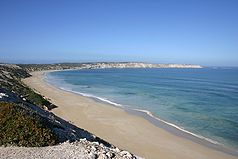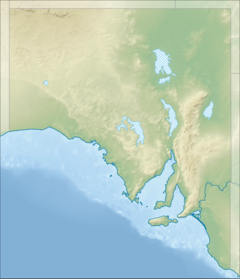Coffin Bay National Park
| Coffin Bay National Park | ||
|---|---|---|
| Avoid Bay with limestone cliffs | ||
|
|
||
| Location: | South Australia , Australia | |
| Specialty: | Sandy beach , cliff coast | |
| Next city: | Port Lincoln , Coffin Bay | |
| Surface: | 310 km² | |
| Founding: | 1982 | |
The Coffin Bay National Park is a 310 km² large national park in the south of the state of South Australia belonging Eyre Peninsula of Australia . The park entrance is near Coffin Bay , 50 kilometers west of Port Lincoln and about 300 kilometers west of Adelaide as the crow flies . The park, founded in 1982, protects a "representative example of a multi-faceted coastal landscape, the variety of which ranges from high, windswept cliffs to huge dunes to beaches with thunderous waves or sheltered sandy bays."
geography
The park covers the area between Coffin Bay and Gunyah Beach as well as the Coffin Bay Peninsula, which extends from Yangie Bay about 25 kilometers in a north-westerly direction into the Great Australian Bay . The main attraction of the former area is Point Avoid, which can be reached via an asphalt road. Further east are the Almonta and Gunyah beaches, where you can surf. Reefs extend from Point Avoid to Golden Island and on to Price Island. The road also leads to Yangie Bay at the southern end of the peninsula, where there is a larger camp site. The access roads to the northern part of the peninsula are only accessible with all-wheel drive vehicles. On this one drives along the northeast side of the peninsula, past Lake Damascus and the striking Point Longnose to Point Sir Isaac, the northernmost tip of the peninsula. The southern part of the peninsula point forms the Whidbey Wilderness Area and can only be reached on foot. See also the map linked below .
history
Originally Aborigines of the Nauo / Barngarla tribe lived in the area of today's park . They lived on meat, fish and native plants. Stone fish traps and earlier storage sites have been found.
The first European to come to Coffin Bay along the coast was the explorer Matthew Flinders . He named the bay on February 16, 1802 after Sir Isaac Coffin, 1st Baronet. In the early 19th century, the area of today's national park was used for whale catching and processing, but this did not last long due to the whale populations that were severely decimated by intensive fishing.
The initial contact between Aboriginal and Europeans was marked by violence. Seal hunters operating from Kangaroo Island abducted Aboriginal women from the Eyre Peninsula to their island. As a result of the European settlement there were numerous armed conflicts.
From 1847 to 1974 the land was used for livestock farming with cattle, sheep and horses. In the late 19th century, fur hunters hunted kusus and derby wallabies .
tourism
The park offers opportunities for fishing, hiking, four-wheel drive and bird watching, and the beaches can be used for swimming and surfing. There are several chargeable campsites. There is also a fee to enter the park itself.
fauna
The park is home to many sea birds, including white-bellied sea eagles and ospreys, as well as various species of albatross and petrels . Western gray kangaroos , emus and goannas also live there . Until February 2004 there were also wild horses, the so-called Coffin Bay ponies , which were relocated to an area outside the national park. The waters surrounding the national park, in which dolphins and whales ( southern right whales ) live, are protected by the Thorny Passage Marine Park .
flora
The Friends of Coffin Bay volunteer group has been helping to eradicate introduced plant species and wild animals for over 20 years in order to restore the original vegetation.
gallery
Web links
swell
- ↑ Official website , accessed June 18, 2015
- ↑ History of the Park . Archived from the original on February 8, 2010. Retrieved June 18, 2015.
- ↑ Coffin Bay Brumbies and 'The Man from Snowy River' effect . Archived from the original on April 2, 2012. Retrieved June 18, 2015.
- ↑ MARINE PARK 5 Thorny Passage . Department of Environment, Water and Natural Resources. Retrieved February 4, 2015.





